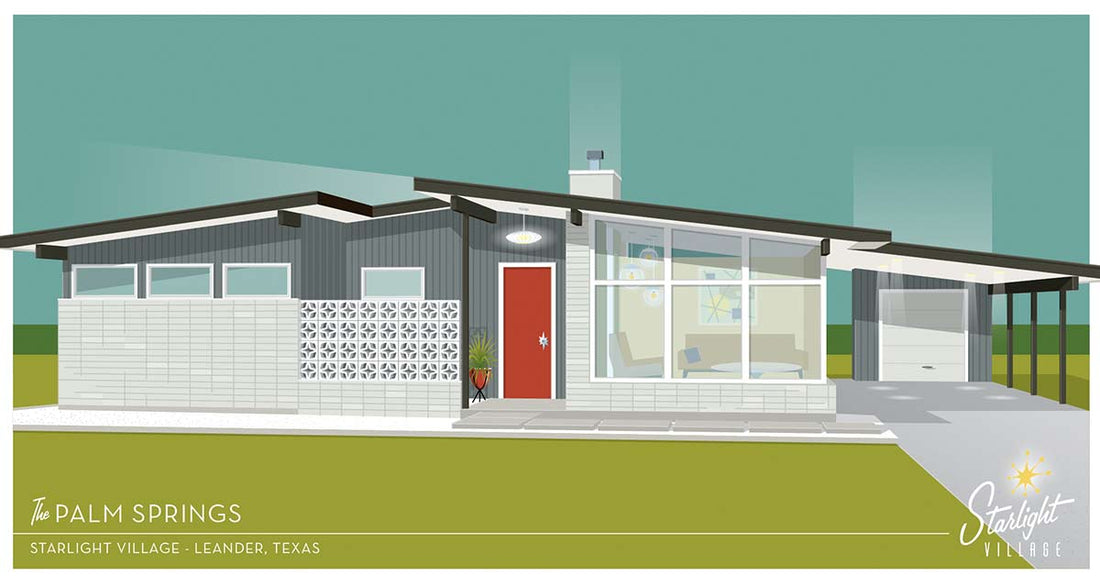
Hallmarks of Mid-Century Modern Home Architecture and Its Enduring Retro Appeal
Share
Life in America began taking on a distinct shape in the latter half of the 1940s and through the 1950s as the country's middle class really came into its own economically and socially. As one of the most significant changes, suburbs became widely regarded as the ideal setting for family life.
During these mid-century modern years, home architecture adapted to keep up with the evolving tastes and priorities of homeowners. Arguably, it was during this period that lifestyle started having a particularly strong influence on home designs across the US. In particular, people eagerly sought kid-friendly living spaces that also facilitated home entertaining and offered a relaxing connection to nature to contrast with the urban environments commonly associated with work.
Mid-century modern home architecture isn't actually a singly style. A lot of what became common at the time grew out of earlier prairie and ranch-style homes, and there were several notable subcategories with their own characteristics and features.
We'll have to be a little general here, as this subject could easily turn into a book. Below are some of the elements that became broadly embraced in mid-century modern home architecture. It's not hard to see why so many aspects of mid-century homes still have a powerful draw for homeowners today.
Simplicity and Clean Lines
These qualities are two of the most important across the board in mid-century modern home architecture. Just about everything was designed with an eye for a minimal, streamlined look. Houses balanced an open feel with a clear delineation of living spaces, and they achieved an uncluttered appearance with a solid sense of organization.Large Windows
Heavy emphasis was placed on bringing plenty of natural light into mid-century modern homes. Large windows and sliding glass doors became common. These features were also coveted because they provided views of the nature—like grass, trees, shrubs, flowers, gardens, birds, and squirrels—in the yard. At the same time, they helped the adults keep an eye on the kids playing in the yard.Kitchen Windows
Windows in the kitchen, especially behind the kitchen sink, also appeared frequently in mid-century homes. As mentioned above, they were perfect for allowing mothers to supervise children in the backyard as they went about their cooking, doing the dishes, and other tasks.Backyard Patios
At-home entertaining of friends, family, neighbors, and coworkers was a big part of social life in 1940s and '50s suburban America. Barbecues were popular, creating demand for outdoor entertainment spaces. Grownups gathered on the patios while the kids played alongside them on the lawn.Natural Materials
The suburbs were intended to create a feeling of seclusion from the city while still offering more convenience than rural areas. Again, because homeowners craved connections to nature, natural materials figured prominently into mid-century modern houses. Wood paneling, beams, and furniture were common, as were stone and brick exterior and interior walls, fireplaces, and walkways.Flat or Gable Roofs
Both types are seen often in mid-century homes, with gable roofs ranging from fairly low slopes to dramatic angles. These satisfied the desire for clean lines and a simple, streamlined look. They also have a way of drawing in the eye and clearly defining the entire living space, an effect also valued inside.Elevation Changes
Single-story homes were common during the era, but so were split-levels. Other elements like partial walls or cabinets of differing heights also created visual elevation changes, which were considered aesthetically pleasing ways to add depth and character. This was seen outside, too, often with some steps in the front yard leading up to the home or to the front door.Air Flow
Air conditioning wasn't a widely available convenience at the time, so home designers paid attention to establishing air flow. Ceiling fans, screen doors, and a dramatic increase in installation of windows that could be opened were ways of doing this. But the house structure itself often helped, as well; windows and doors were placed on opposite walls so that air circulation though the house became possible.Article Feature Image Credits: Starlight Village, Texas - a brand new community designed totally in mid-century modern fashion!
